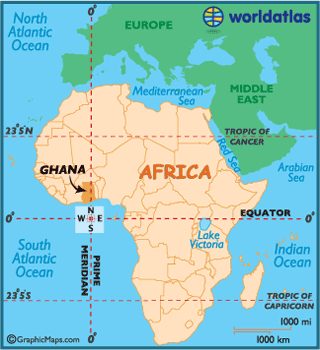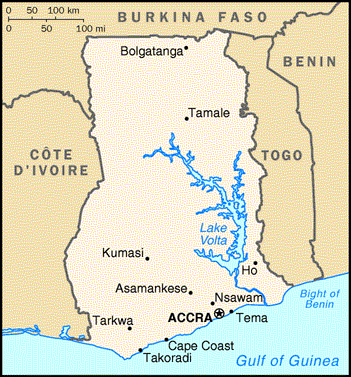
Ghana
Beautiful African country


Geography
Ghana is located on West Africa’s Gulf of Guinea only a few degrees north of the Equator. With a total area of 238,538 sq km, the country is bounded by:
-
Côte d’Ivoire to the west
-
Burkina Faso to the north
-
Togo to the east
-
The Atlantic Ocean to the south.
Climate
The climate of Ghana is tropical. Except in the north two rainy seasons occur, from April to July and from September to November.
-
In the north the rainy season begins in April and lasts until September.
-
The harmattan, a dry desert wind, blows from the northeast from December to March, lowering the humidity and creating hot days and cool nights in the north.
-
In the south the effects of the harmattan are felt in January.
Average temperatures range between 21° and 32°C, with relative humidity between 50% and 80%.
Ghana's Flag
Ghana Country
African's land...
gold landscapes!
 Africa view.gif |
|---|
 Ghana Geography.gif |
 ghana land.gif |




 bandera1.png |
|---|
The flag of Ghana was created by Theodosia Okoh after independence in 1957 and was the first African flag. Each color has a significant meaning:
-
Red: represents the blood of those who died in the wars for independence
-
Yellow: represents the mineral wealth of the country
-
Green: symbolizes the forests and natural wealth
-
The black star: Africa represents freedom
Ghana's Currency
The Cedi appeared in 1965 to replace the Ghanaian pound and was replaced by another currency, also called the Cedi in 1967.
-
Ghana Bank put into circulation coins of 50, 100, 200 and 500 Cedis and banknotes 1,000, 2,000, 5,000, 10,000 and 20,000 Cedis.
-
In July 2007, were put into circulation new banknotes and coins issued in the new national currency; bills 10,000, 50,000, 100,000, 200,000 and 500,000 Cedis; coins 100, 500, 1000, 2000 and 5000 Cedis
